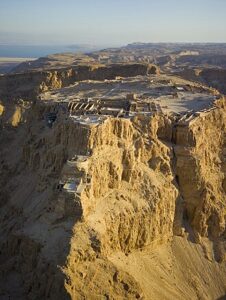
TEL AVIV, Israel (Press Release) — Researchers from the Sonia & Marco Nadler Institute of Archaeology at Tel Aviv University (TAU) used a range of modern technologies, including drones, remote sensing, and 3D digital modeling, to generate the first objective, quantified analysis of the Roman siege system at Masada.
Findings indicate that, contrary to a widespread myth, the Roman army’s siege of Masada in 73 CE lasted no more than a few weeks.
The study was conducted by the Neustadter expedition from TAU’s Nadler Institute of Archaeology, headed by Dr. Guy Stiebel, together with Dr. Hai Ashkenazi, Head of Geoinformatics at the Israel Antiquities Authority, and PhD candidates Boaz Gross from TAU and the Israeli Institute of Archaeology and Omer Ze’evi-Berger from the University of Bonn. The study is part of the expedition’s extensive mission, implementing advanced tools and posing fresh questions, to attempt a new understanding of what really happened at Masada. The paper was published on August 29, 2024, in the Journal of Roman Archaeology.
Watch this video for a drone’s-eye view of the site: https://youtu.be/4z18V8PxzkA
“In 2017, on behalf of TAU’s Nadler Institute, my expedition renewed excavations at Masada, a world-famous site explored extensively since the early 19th century and throughout the 20th century,” Dr. Stiebel says. “Our expedition sets forth several new questions and implements many novel research tools that were not available to previous generations of archaeologists. As part of this extensive project we devote much scholarly attention to the site’s surroundings. We use drones, remote sensing, and aerial photography to collect accurate high-resolution data from Masada and its environs, with special emphasis on three aspects: the water systems, the trails leading to and from the palatial fortress, and the Roman siege system.
“This information is then used to build 3D digital models that provide us with a clear and precise image of the relevant terrains. In the current study we focused on the siege system, which, thanks to the remote location and desert climate, is the best-preserved Roman siege system in the world.”
For many years, the prevailing theory that became a modern myth asserted that the Roman siege of Masada was a grueling three-year affair, Dr. Stiebel adds. In recent decades researchers have begun to challenge this notion, for various reasons. In this first-of-its kind study, the archaeologists examined the issue with modern technologies that enable precise objective measurements.
The researchers used drones carrying remote sensors that provided precise, high-resolution measurements of the height, width, and length of all features of the siege system. This data was used to build an accurate 3D digital model, enabling exact calculation of the structures’ volume and how long it took to build them.
“Reliable estimates are available of the quantity of earth and stones a Roman soldier was able to move in one day,” Dr. Ashkenazi notes. “We also know that approximately 6,000-8,000 soldiers participated in the siege of Masada. Thus, we were able to objectively calculate how long it took them to build the entire siege system — eight camps and a stone wall surrounding most of the site. We found that construction took merely about two weeks.
“Based on the ancient historical testimony, it is clear that once the assault ramp was completed, the Romans launched a brutal attack, ultimately capturing the fortress within a few weeks at the most. This leads us to the conclusion that the entire siege of Masada lasted no more than several weeks.”
“The narrative of Masada, the Great Jewish Revolt, the siege, and the tragic end as related by Flavius Josephus, have all become part of Israeli DNA and the Zionist ethos, and are well known around the world,” Dr. Stiebel concludes. “The duration of the siege is a major element in this narrative, suggesting that the glorious Roman army found it very difficult to take the fortress and crush its defenders.
“Based on our findings, we argue that the Roman siege of Masada took a few weeks at the most. As empires throughout history have done, the Romans came, saw, and conquered, quickly and brutally quelling the uprising in this remote location. Our conclusion, however, detracts nothing from the importance of this historical event, and many baffling questions remain to be investigated.”
*
Preceding provided by the American Friends of Tel Aviv University
A depressing result to a great story of resistance over tyranny.
This is fascinating. The exploration by drone really sheds new light on our history. Thank you for sharing this provocative information.